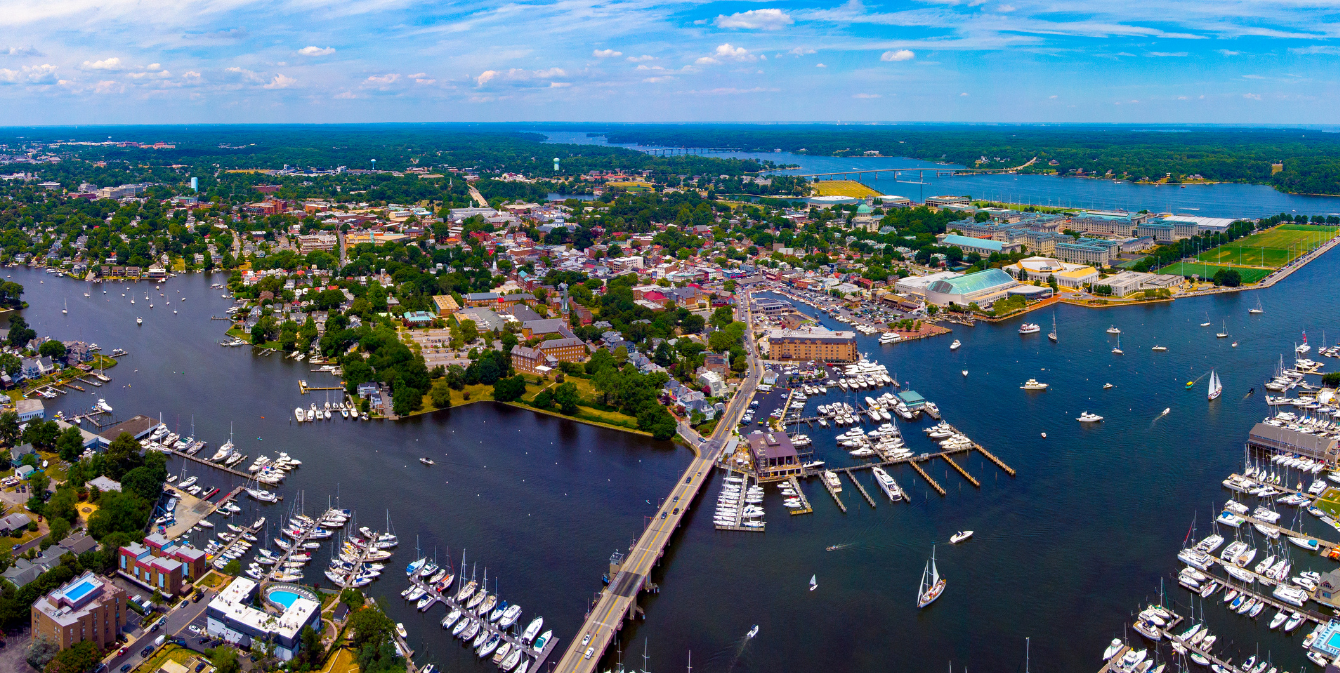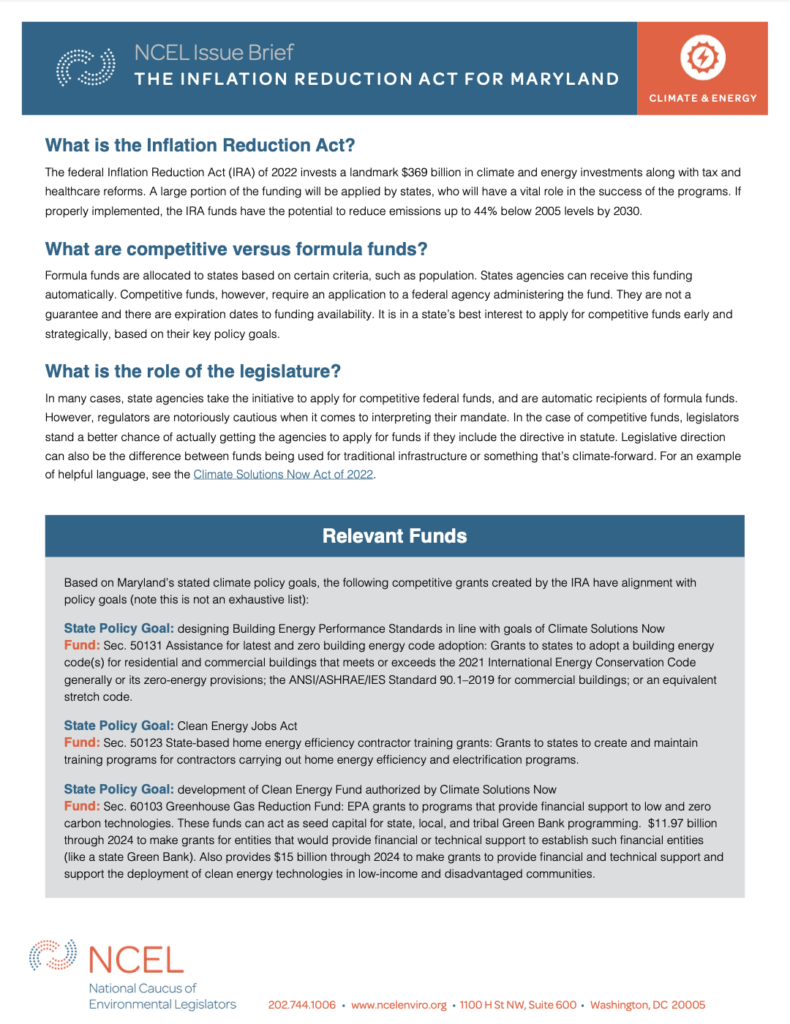
Issue Brief
The Inflation Reduction Act for Maryland
Overview
The federal Inflation Reduction Act (IRA) of 2022 invests a landmark $369 billion in climate and energy investments along with tax and healthcare reforms. A large portion of the funding will be applied by states, who will have a vital role in the success of the programs. If properly implemented, the IRA funds have the potential to reduce emissions up to 44% below 2005 levels by 2030. Based on Maryland’s stated climate policy goals, this issue brief details the competitive grants created by the IRA which have alignment with policy goals.

What is the Inflation Reduction Act?
The federal Inflation Reduction Act (IRA) of 2022 invests a landmark $369 billion in climate and energy investments along with tax and healthcare reforms. A large portion of the funding will be applied by states, who will have a vital role in the success of the programs. If properly implemented, the IRA funds have the potential to reduce emissions up to 44% below 2005 levels by 2030.
What are competitive versus formula funds?
Formula funds are allocated to states based on certain criteria, such as population. States agencies can receive this funding automatically. Competitive funds, however, require an application to a federal agency administering the fund. They are not a guarantee and there are expiration dates to funding availability. It is in a state’s best interest to apply for competitive funds early and strategically, based on their key policy goals.
What is the role of the legislature?
In many cases, state agencies take the initiative to apply for competitive federal funds, and are automatic recipients of formula funds. However, regulators are notoriously cautious when it comes to interpreting their mandate. In the case of competitive funds, legislators stand a better chance of actually getting the agencies to apply for funds if they include the directive in statute. Legislative direction can also be the difference between funds being used for traditional infrastructure or something that’s climate-forward. For an example of helpful language, see the Climate Solutions Now Act of 2022.
Relevant Funds
Based on Maryland’s stated climate policy goals, the following competitive grants created by the IRA have alignment with policy goals (note this is not an exhaustive list):
State Policy Goal: designing Building Energy Performance Standards in line with goals of Climate Solutions Now
Fund: Sec. 50131 Assistance for latest and zero building energy code adoption: Grants to states to adopt a building energy code(s) for residential and commercial buildings that meets or exceeds the 2021 International Energy Conservation Code generally or its zero-energy provisions; the ANSI/ASHRAE/IES Standard 90.1–2019 for commercial buildings; or an equivalent stretch code.
State Policy Goal: Clean Energy Jobs Act
Fund: Sec. 50123 State-based home energy efficiency contractor training grants: Grants to states to create and maintain training programs for contractors carrying out home energy efficiency and electrification programs.
State Policy Goal: development of Clean Energy Fund authorized by Climate Solutions Now
Fund: Sec. 60103 Greenhouse Gas Reduction Fund: EPA grants to programs that provide financial support to low and zero carbon technologies. These funds can act as seed capital for state, local, and tribal Green Bank programming. $12 billion through 2024 to make grants for entities that would provide financial or technical support to establish such financial entities (like a state Green Bank). Also provides about $8 billion through 2024 to make grants to provide financial and technical support and support the deployment of clean energy technologies in low-income and disadvantaged communities.
State Policy Goal: implementation of environmental justice provisions in Climate Solutions Now
Fund: Sec. 60114 Climate Pollution Reduction Grants: Creates two grant programs through EPA:
- Greenhouse Gas Air Pollution Planning Grants: grants for at least one eligible entity per state to develop a plan to reduce greenhouse gas air pollution. Plans shall outline programs, policies, measures, and projects that will reduce greenhouse gas air pollution.
- Greenhouse Gas Air Pollution Reduction Implementation Grants: competitive grants to implement the plan described above.
State Policy Goal: Multi-State Medium- and Heavy-Duty Zero-Emission Vehicle Action Plan & Clean Trucks Act of 2023 (H.B.0230/S.B.0224)
Fund: Sec. 60101 Clean Heavy-Duty Vehicles: Creates a grant program for eligible contractors, including states, for providing rebates, for up to 100 percent of costs for the incremental costs of replacing an eligible vehicle that is not a zero-emission vehicle with a zero-emission vehicle, purchasing, installing, operating, and maintaining infrastructure needed to charge, fuel, or maintain zero-emission vehicles; workforce development and training to support the maintenance, charging, fueling, and operation of zero-emission vehicles; and planning and technical activities to support the adoption and deployment of zero-emission vehicles.
Fund: Sec. 60102 Grants to Reduce Air Pollution at Ports: Creates a rebates and grant program to eligible recipients on a competitive basis to purchase or install zero-emission port equipment or technology for use at, or to directly serve, one or more ports; to conduct any relevant planning or permitting in connection with the purchase or installation of such zero-emission port equipment or technology; and to develop qualified climate action plans.
State Policy Goal: Equity in Transportation Sector bill (S.B.0019/H.B.0009)
Fund: Sec. 60501 Neighborhood Access and Equity Grant Program: Allocates funding to the Federal Highway Administration for a competitive grant program to:
support efforts to improve walkability, safety, and affordable transportation access;
mitigate or remediate negative impacts on the human or natural environment resulting from a facility in a disadvantaged or underserved community;
support planning and capacity building activities in disadvantaged or underserved communities.
State Policy Goal: Offshore Wind Energy Act of 2013, Clean Energy Jobs Act of 2019, and Promoting Offshore Wind Energy Resources Act (S.B.0781/H.B.0793)
Fund: Sec. 50153 Interregional and Offshore Wind Electricity Transmission Planning, Modeling, and Analysis: planning, modeling, analysis, and development of interregional transmission and optimized integration of energy generated from offshore wind.
State Policy Goal: Increased transmission lines is essential to meeting Maryland’s greenhouse gas reduction mandates and to deliver the lowest-cost clean power to Maryland households. The Maryland legislature introduced H.B.0692/S.B.0489 this year, which would require expedited processing of any local permit for transmission lines.
Fund: Grants to Facilitate the Siting of Interstate Electricity Transmission Lines (Sec. 50152): States can use the grants for transmission project studies, examination of alternative siting corridors, hosting negotiations with project backers and opponents, participating in federal and state regulatory proceedings, and promoting economic development in affected communities. The siting decision must take place within two years.

Empower State Environmental Champions
Your donation funds the fight for equitable actions that protect the environment and our health.
Donate